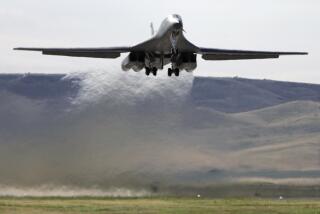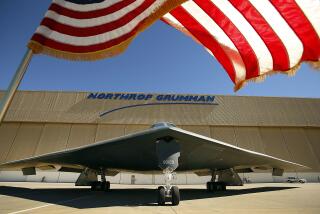Rockwell to Lay Off 4,450 in Southland
Rockwell International plans to lay off 6,800 workers across the country during the next five months, including 4,450 in the Los Angeles area, as the B-1 bomber manufacturing program passes its peak activity, company officials disclosed Wednesday.
Although deliveries of B-1s to the Air Force will continue at the rate of four a month through mid-1988, a large portion of Rockwell’s vast B-1 work force has completed its task of building parts.
The layoffs will include 3,250 workers at Rockwell International’s plants in El Segundo and 1,200 workers at the firm’s final assembly complex in Palmdale, according to Sam Iacobellis, president of Rockwell’s North American Aircraft unit.
An additional 650 workers in Tulsa, Okla., and 1,700 workers in Columbus, Ohio, will be laid off by October as well. Rockwell plants in those cities build a number of B-1 components, such as fuselage sections, wing flaps and engine housings.
Rockwell’s cutbacks amount to more than 25% of the 27,000 workers that the B-1 program employed when it peaked this month. So far, only several hundred workers have been laid off, but large-scale cutbacks will begin within weeks. Rockwell is building 100 of the strategic jet bombers at a cost of $27.5 billion.
While the Rockwell layoffs are linked to the B-1’s production schedule, they come amid concern that employment in Southern California’s defense industry could be hurt by the Gramm-Rudman budget-cutting bill. But it remains unclear whether defense employment here has crested. A number of major aircraft, missile and electronics programs are still building up, and an immediate precipitous decline in aerospace employment is not apparent.
Unlike most military aircraft programs, the B-1 program was structured by the Air Force to build up production rapidly and wind down quickly.
Rockwell had delivered only a few of the bombers by early this year, but today it is preparing to flight-test ship No. 32. When it reaches the so-called rate production of four aircraft per month this summer, it will be delivering an unprecedented $1.1-billion worth of equipment monthly.
This fast-track schedule was designed to move the bombers into operation as quickly as possible and save the government money by producing them at the most efficient manufacturing rate.
Maximum Job Dislocation
But the fast-track production also creates a maximum of job dislocation, requiring a tremendous hiring campaign by Rockwell for a work force that has a life expectancy of only half a dozen years.
It also puts tremendous stress on the production system because billions of dollars worth of parts must come together with perfect coordination to avert costly delays in the program. So far, Rockwell’s performance has been praised as a model of efficiency.
In addition to Rockwell, various associate contractors and subcontractors, who build everything from landing gears to wings, also face a sharp wind-down over the coming months.
Employment at the 5,000 associate and subcontractor firms that are involved in the B-1 program is estimated at 27,000, Iacobellis said. Since nobody tracks employment at each of the 5,000 firms, the exact number of coming layoffs outside Rockwell is unknown. But they are expected to be somewhat more severe than Rockwell’s because piece-part production winds down more quickly than assembly operations.
Iacobellis said some of the layoffs may be averted if the firm receives supplemental contracts for B-1 modifications, but those offsets would, at most, spare 20% of the jobs scheduled for elimination.
The layoffs come just as political efforts are gaining intensity to continue production of the B-1. Rockwell has proposed selling the Air Force 48 additional aircraft at a cut-rate price of $195 million each, compared to $275 million each for the first 100.
Support in Congress
The proposal has gained support in Congress, despite the Pentagon’s longstanding plan to stop the B-1 program after production of 100 aircraft and to begin procurement of Northrop’s Stealth bomber. The B-1 is a swing-wing, multipurpose bomber designed to fly over enemy territory at low level and at subsonic speeds. The Stealth is designed to be virtually undetectable by radar, using a variety of new technology.
Supporters of the B-1 believe it would be unwise for the Air Force to lose the capability of building the B-1 before it is certain that the highly advanced Stealth can be produced at an affordable price.
Although details of the Stealth are shrouded in secrecy, it is believed that the program will cost as much as $80 billion for 132 aircraft. Critics contend that continued production of the B-1 would represent a competitive threat to the Stealth that would contain the cost of the Stealth program.
But all of the options, including continued production of a combination of the bombers or production of only a new Stealth bomber, pose difficult problems under the restrictive military budgets that are expected in the future.
More to Read
Inside the business of entertainment
The Wide Shot brings you news, analysis and insights on everything from streaming wars to production — and what it all means for the future.
You may occasionally receive promotional content from the Los Angeles Times.











